 Welcome
Welcome"We alway write an image to someone." (Folon; BMCc from memory)
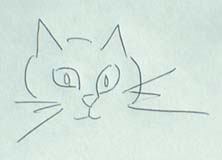 |
 |
In the mid-1980's I created what I called my "Envelope Art". I would make designs on postal envelopes and mail them to friends. Note 1: There is a Rizzoli publication: "Lettres a Giorgio", by Jean-Michel Folon (Belgian, 1934--2005), which consists of beautiful watercolor painted envelopes. Obviously, Folon's envelopes are much better art than mine. On the other hand, I have always believed I came up with my idea before I saw the Rizzoli book, i.e., I do not think I copied my artform from something I had seen somebody else do. I reinvented this wheel all by my ownsome. Note 2: My art was limited by my profound lack of freehand drawing talent/skill, the limit of which is something like a simple cat face (above). Note 3: I even got a publication out of my "envelope art": "The Envelope as an Art Form: Computer-Aided Images". Leonardo: Journal of the International Society for the Arts, Science and Technology, 1984, 17(1).
Most of the time I programmed my design using an IBM Research vector graphics application, YDS (Yorktown Drawing System), which rendered the image on a Tektronix monitor. I printed the image on IBM Research's high-resolution photo compositor (APS-5), Xerox copied that, cut and folded and pasted one of the copies, added postage stamp(s) (integrated into the design...), and mailed it. I would usually take each letter to a Post Office and ask the Post Office clerk to hand-cancel it, occasionally even asking the clerk to put the postmark in a specific position.
Reactions from Post Office employees ranged from the Post Mistress (female Postmaster) of the Crompond, New York post office, who found the envelopes delightful (I made/sent her one), to a Post Office clerk who grumbled that what I was doing was against postal regulations. As best I know, all my "envelopes" got delivered to their intended recipients. I would sometimes mail two copies of the envelope, and ask the recipient to return one to me for my archive.
Following are eleven examples[1]:
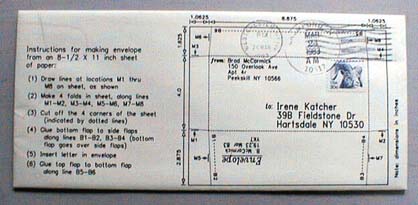

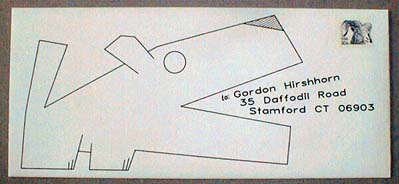


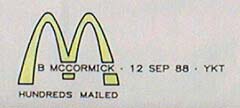
Here's a different piece of my mailart (not produced at IBM Research). Professor McClintock had a competition, in the TC Department of Communication in Education, to design a picture for a project about Maxwell's Demon (I forget the details), ca. 1985. Maxwell's Demon is a clever little dude who beats universal Entropy by creating more order than his very act of creating that order produces new disorder. I believe mine was the only entry submitted, so I think I won by default (or maybe the prize was withdrawn for lack of enough competitors → for how can one person compete against just themself?).
My entry: a very poorly drawn (the best I could do![4]) elevator operator, who puts particles (ASCII characters) flying around in random motion, each, off at the floor where it will contribute to universal good order without generating collateral damage entropic side-effects. He does this by opening and closing a sliding door, to let each individual particle fly out of the random motion chamber (left) into its proper place in the ordered text chamber (right), at just the right moment. Such a triumph of mind over matter is not possible, just like it is not possible to cool a whole room by running an unventilated air conditioner in the middle of said room (such an air conditioner just moves the existing heat in the room around, while adding the heat generated by its own operation to it).

When I went to get my 2nd Covid-19 vaccine shot (+2021.04.06), I took 5 copies of this poster and distributed them to persons working in the vaccination center. At least 2 of them recognized Sir Winston and liked it.

Below left: There was a big todo in The New York Times newspaper (+2021.04.12) about the "Salvator Mundi" painting which apparently Leonardo da Vinci painted but from the picture it looks like kitsch to me. A tempest in a teapot. Below right: Everybody's favorite sculpture. Welcome to the art world!
If you are discouraged that you cannot create any art, copy the picture below and add your own text to create your own cartoon, or modify it any other way you may want. Please do not try to use it for profit-making purposes, thank you. Where there's a will, there's sometimes a way.
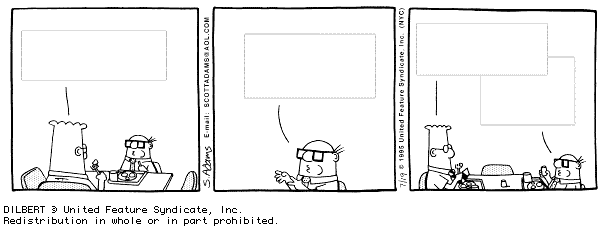
If I who can draw nothing but a simple cat face (I would like to be a [wise and long lived] house cat) can do it, you can too. Below is a Mondriaan painting which I have rotated 45° and signed. "Go[l]d is in the details." (Mies van der Rohe; BMcC modified) Below that is a cartoon I have modified with the most rudimentary MS Windows "paint" and screen shot programs, again, with zero "artistic" ability or skill, and some persons have liked it on Quora (not that that makes it any good, of course).
|